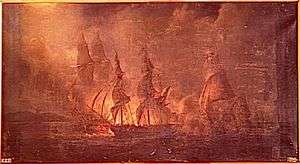French frigate Sirène (1795)
 Combat de la frégate française La Sirène contre une division anglaise, by Pierre-Julien Gilbert | |
| History | |
|---|---|
| Name: | Sirène |
| Builder: | Bayonne |
| Laid down: | June 1794 |
| Launched: | 1795 |
| In service: | 1795 |
| Fate: | Broken up in 1825 |
| General characteristics | |
| Class and type: | Coquille class frigate |
| Tons burthen: | 898 bm |
| Length: | 42.8 m (140 ft) |
| Beam: | 11.4 m (37 ft) |
| Draught: | 5.3 m (17 ft) |
| Depth of hold: | 3.6 m (12 ft) |
| Propulsion: | Sails |
| Sail plan: | Ship |
| Armament: | 28 × 12-pounder + 12 × 8-pounder guns |
The Sirène was a 40-gun Coquille class frigate of the French Navy. She took part in a number of campaigns and actions before she was badly damaged in a battle on 22 March 1808. Refloated after being beached to avoid capture, she was hulked. Sirène was broken up in 1825.
Career
Begun as Fidèle, she was commissioned as Sirène in May 1795 under Lieutenant Charles Berrenger. She took part in the Expédition d'Irlande.
On 8 June Sirène was part of a Franco-Spanish fleet under Admiral Villeneuve, which intercepted a homeward-bound convoy of 15 merchant vessels under the escort of the frigate Barbadoes and the schooner or sloop Netley. The two British warships managed to escape, but Villeneuve's fleet captured the entire convoy, valued at some five million pounds. He sent the convoy to Guadelopue under the Sirène' escort.[1] However, as she was escorting the prizes, she encountered several British frigates. She escaped after burning the merchantmen.
Sirène took part in the Battle of Cape Finisterre on 22 July 1805. In March of the following year, she took part in an expedition to destroy English whaling ships.
In March 1808, Sirène, under Guy-Victor Duperré, and the 44-gun Italienne, under Captain Hugues Méquet, ferried troops to Martinique. On 22 March they encountered a British squadron comprising the 74-gun HMS Impetueux (Captain John Lawford) and HMS Saturn, as well as the frigates HMS Aigle (Captain George Wolfe) and HMS Narcissus, which chased them. It seemed at first that the French squadron would easily beat the British to Lorient, but as they closed to shore, the wind became too weak and the frigates had to be taken in tow by their boats. By the time wind had returned, Impetueux and Aigle had closed so much that Duperré deemed it impossible to reach Lorient before being caught, and he decided to seek the support of the batteries at Groix. At 20:30, Sirène was taken in a cross-fire of Aigle, which sailed between her and shore, and Impetueux on the other side. The gunnery exchange lasted one hour and a quarter, after which the British withdrew. Fearing that the British would attack again before he could moor Sirène in a strong defensive position, Duperré beached her at Pointe des Chats, under the Lacroix battery. Sirène was refloated on 26 March, and rejoined Italienne in Lorient harbour.[2] This action was immortalised by a painting by Pierre-Julien Gilbert.[3][4] In British literature, Sirène is sometimes mistaken for Seine.[5]
Fate
Too badly damaged to be repaired,Sirène was used as a hulk in Lorient. She was broken up in 1825.
Citations
- ↑ James (1837), Vol. 3, p.351.
- ↑ Batailles navales de la France, O. Troude, Challamel ainé, 1867, vol.3, p. 502
- ↑ Galeries historiques du palais de Versailles. Tome 4, C. Gavard Gallica
- ↑ COMBAT DE LA FREGATE FRANCAISE "LA SIRENE" CONTRE UNE DIVISION ANGLAISE.22 MARS 1808, Pierre-Julien Gilbert Joconde
- ↑ Naval history of Great Britain, vol. V, p.26
References
- James, William (1837). The Naval History of Great Britain, from the Declaration of War by France in 1793, to the Accession of George IV. R. Bentley.
- Roche, Jean-Michel (2005). Dictionnaire des bâtiments de la flotte de guerre française de Colbert à nos jours 1 1671 - 1870. ISBN 978-2-9525917-0-6. OCLC 165892922.